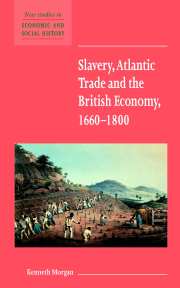Book contents
- Frontmatter
- Contents
- List of maps
- List of tables
- Acknowledgements
- Introduction
- 1 The context
- 2 The debates
- 3 The profits of the slave trade
- 4 Slavery, Atlantic trade and capital accumulation
- 5 British exports and transatlantic markets
- 6 Business institutions and the British economy
- 7 Atlantic trade and British ports
- Conclusion
- Bibliography
- Index
- Cambridge Cultural Social Studies
4 - Slavery, Atlantic trade and capital accumulation
Published online by Cambridge University Press: 05 June 2012
- Frontmatter
- Contents
- List of maps
- List of tables
- Acknowledgements
- Introduction
- 1 The context
- 2 The debates
- 3 The profits of the slave trade
- 4 Slavery, Atlantic trade and capital accumulation
- 5 British exports and transatlantic markets
- 6 Business institutions and the British economy
- 7 Atlantic trade and British ports
- Conclusion
- Bibliography
- Index
- Cambridge Cultural Social Studies
Summary
Another line of analysis in determining the contribution of transatlantic commerce to British economic growth emphasises the flow of capital from slavery and the Atlantic trading system into British industry. This linkage underpins many passages in Eric Williams's Capitalism and Slavery. A central concern is the argument that capital accumulation in Britain was boosted by the wealth produced by the Caribbean plantations, wealth based on the productivity of slaves and the profits of the sugar trade. This seems an obvious mode of enquiry, for the West Indian islands were the richest part of the first British Empire. It also seems reasonable to assume that entrepreneurs investing in the Caribbean, so far a distance from home, felt they could achieve better returns there than from channelling funds into domestic sectors of the British economy. The scale of West Indian wealth was recognised in the eighteenth century. Planters reckoned that the value of the British Caribbean islands amounted to £50–60 million in 1775 and to £70 million in 1789 (Drescher, 1977: 22–3). Contemporaries acknowledged the economic status of the West India plantocracy, notably the large numbers of absentees who lived in fine mansions with country estates rather than in the heat and dust of the Caribbean.
- Type
- Chapter
- Information
- Publisher: Cambridge University PressPrint publication year: 2001



